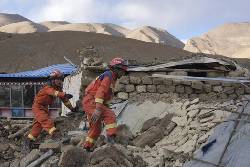BEIJING (AP) — Rescuers in the freezing, high-altitude Tibet region in western China searched a second day for any remaining victims of a deadly earthquake that struck near a holy city for Tibetan Buddhists, before shifting their focus to resettling the survivors.
More tents, quilts, stoves and other relief items were being delivered Wednesday to people whose homes were uninhabitable or unsafe. Temperatures fall well below freezing overnight in an area with an average altitude of about 4,200 meters (13,800 feet).
In video aired by state broadcaster CCTV, workers could be seen erecting rows of tents with metal frames and stakes after nightfall Tuesday. Meant as temporary shelter, they were lined with quilted padding to keep out the cold. The workers distributed packaged food items to the shelter occupants, donning blue winter jackets over their orange uniforms.
The confirmed death toll stood at 126 with another 188 injured as of Tuesday evening, and no further updates were issued during the day on Wednesday. Hong Li, the director of Tibet's Emergency Management Department, told a late afternoon news conference that the work had shifted from search and rescue to resettlement and reconstruction.
The earthquake struck an outlying county in the city of Shigatse, the traditional seat of the Panchen Lama, the second-highest figure in Tibetan Buddhism. It was not immediately known whether he was in his Tashi Lhunpo Monastery at the time or how much damage Tibet's second largest city sustained. The epicenter was about 25 kilometers (15 miles) from the main part of the city, which is called Xigaze in Chinese and sprawls across a high altitude plain.
More than 500 aftershocks were recorded after the earthquake, which the U.S. Geological Survey said measured magnitude 7.1. China’s earthquake center recorded a magnitude of 6.8. The quake was also about 75 kilometers (50 miles) from Mount Everest and the border with Nepal, where the shaking sent people running out of their homes in the capital.
A candlelight vigil was planned on Wednesday night in Dharamsala, India, home to the Dalai Lama, Tibetan Buddhism’s highest figure, and a large Tibetan population. An announcement on the Dalai Lama’s website said he would lead a prayer ceremony in memory of the victims on Thursday.
The Dalai Lama is viewed by the Chinese government as bent on making Tibet independent of China.
Asked about the prayer ceremony, Chinese Foreign Ministry spokesperson Guo Jiakun said, “We are very clear about the separatist nature and political schemes of the Dalai Lama and remain highly vigilant.”
Guo expressed confidence that the people in the earthquake zone will be able to rebuild under “the strong leadership” of China's ruling Communist Party.
The Chinese government and followers of the Dalai Lama have feuded over who should hold the position of Panchen Lama since a boy appointed by the Dalai Lama disappeared in the mid-1990s and a Chinese-backed candidate was approved for the position. The Dalai Lama denounced the move and has refused to recognize the current Panchen Lama.
China's government says Tibet has been part of its territory for centuries, but many Tibetans say they were functionally independent for most of that time. China's People's Liberation Army invaded the territory in 1950 and the Dalai Lama fled to India nine years later during an uprising against Chinese rule, seen as eroding Tibet's unique Buddhist culture.
The death toll from the quake included at least 22 of the 222 residents of Gurum, the official Xinhua News Agency cited the village’s Communist Party chief, Tsering Phuntsog, as saying. The victims included his 74-year-old mother, and several other of his relatives remained buried in the debris.
“Even young people couldn’t run out of the houses when the earthquake hit, let alone old people and children,” Tsering Phuntsog said.
State broadcaster CCTV showed orange-suited rescue workers with sniffing search dogs clambering over huge chunks of debris in the wreckage of homes. In the hardest-hit areas, rows of houses had been reduced to rubble. Blue disaster emergency tents with bright red Chinese flags flapping in the wind had been set up nearby.
More than 3,600 houses collapsed, according to a preliminary survey, and 46,000 residents had been relocated, state media said.
Tibet is generally closed to foreign journalists over reports about the ill treatment of the population by Chinese authorities.
Chinese Vice Premier Zhang Guoqing, who visited survivors in the quake-hit area, called for the acceleration of post-disaster reconstruction to ensure they can be safe and warm this winter, Xinhua reported. Power and communications in the area have been restored, allowing smoother delivery of emergency goods, it said.
___
Bodeen reported from Taipei, Taiwan.
...


 Copyright © 1996 - 2025 CoreComm Internet Services, Inc. All Rights Reserved. | View our
Copyright © 1996 - 2025 CoreComm Internet Services, Inc. All Rights Reserved. | View our